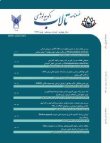Evaluating water quality of kangir river by means of NSF water quality index and the effect of reducing the load of point pollutants on increasing the index rate using QUAL2KW model
population growth and pollutions from sewage discharged of various land uses have resulted in expansion of pollution and water resource constraints. One of the simplest ways to determine qualitative condition of water is using water qualitative indicators that could be used as a decision making tool by managers and experts. NSF is a comprehensive index and efficient tool to determine water quality and classify water resources based on quality; and, it is more applicable than other qualitative indicators of water. The study deals with qualitative review of Kangir River in Ilam Province, through NSFWQI indicator. Qualitative and quantitative data required including those related to the river during two dry and wet seasons have been obtained for 5 stations, from Department of Environment and Regional Water Company in Ilam. Results obtained from the indicator showed that water qualities of river in all points are classified as average and low. Highest indicator value (66) has been related to first station (December 22nd- January 20the); and, lowest value has been related to second station (30) and during Tir and Shahrivar months (June 22nd-July 22nd and August 23rd-September 22nd), after sewage discharge. Throughout the river, quality of water takes an improvement trend so that in last station and near Kangir Dam, again quality of water goes back to average, Which indicates the ability of the river to self-purify. Main reason for reduction of NSF indicator is discharge of non-treated sewage and high value of such parameters as BOD and coliforms, in addition to reduction of DO. In addition to usage made of qualitative indicators, to determine expected reaction of river caused by pollutants, mathematical models have to be used. In present study and to simulate pH, BOD, dissolved oxygen, temperature, and coliform, QUAL2KW model has been used which makes a single dimension simulation of the river, along with non-uniform steady flow. Day and Mordad months (December 22nd- January 20th and August 23rd-September 22nd) have been selected as wet and dry periods of the year; and, the model has been calibrated for each period, separately. Then, 50% reduction scenario in coliform and BOD from point resource of pollution has been implemented for the model under fixed temperature and flow rate. It was shown that NSFWQI indicator would be increased in stations, if the scenario would be performed; and, the increase depends on taking effect from point resources of pollution. Maximum increase of NSFWQI index for Alamdar station (after discharging municipal sewage) by an average of 10 And the minimum increase in the index for the Kapne kran station (last station) will be an average of 2.
- حق عضویت دریافتی صرف حمایت از نشریات عضو و نگهداری، تکمیل و توسعه مگیران میشود.
- پرداخت حق اشتراک و دانلود مقالات اجازه بازنشر آن در سایر رسانههای چاپی و دیجیتال را به کاربر نمیدهد.


